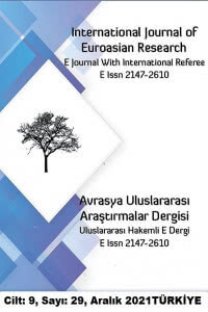DEĞİŞKEN ÖZGÜRLÜK ALGI VE DENEYİMLERİ: HESTER PRYNNE VE KÂTİP BARTLEBY ÖRNEKLERİ
UNSTABLE EXPERİENCES AND PERCEPTİON OF FREEDOM: THE CASES OF “HESTER PRYNNE” AND “BARTLEBY THE SCRİVENER”
___
- ACHTENBERG, Deborah, (2014), "Freedom", Essential Vulnerabilities: Plato and Levinas on Relations to the Other, 40-70. Evanston, Illinois: Northwestern University Press.
- ATAYMAN, Veysel, (2014), “Önsöz” N. Hawthorne, Kızıl Harf -Damgalı Kadın, (Çeviren: Alican Azeri), pp.11-24. İstanbul: Bordo Siyah.
- BARLOWE, Jamie, (1997), “Rereading Women: Hester Prynne-ism and The Scarlet Mob Of Scribblers”, American Literary History, vol. 9, no. 2, pp. 197– 225. JSTOR,www.jstor.org/stable/490281.
- BASKETT, Sam S, (1961), “The (Complete) Scarlet Letter”, College English, vol. 22, no. 5, pp. 321–328.
- BELL, Michael Davitt, (1997), “Arts Of Deception: Hawthorne, 'Romance,' And The Scarlet Letter” Colacurcio 29-56.
- BOLLAS, Christopher, (1974), “Melville's lost self: ‘Bartleby’” American Imago, vol. 31, no. 4, pp. 401–411.
- BUSCH, Frederick, (1977), “Thoreau and Melville as Cellmates” Modern Fiction Studies, vol. 23, no. 2, pp. 239–242. JSTOR, www.jstor.org/stable/26280193.
- DESMARAIS, Jane, (2001), “Preferring not to:The Paradox of Passive Resistance in Herman Melville’s “Bartleby””, Journal of the Short Story in English [Online], 36 | Spring, Online since 29 September 2008, connection on 10 December 2020. URL : http://journals.openedition.org/jsse/575
- DOUBLEDAY, Neal Frank, (1939),” Hawthorne's Hester and Feminism”, PMLA, vol. 54, no. 3, pp. 825–828. JSTOR, www.jstor.org/stable/458487.
- GERVAIS, Roland J, (1979), “A Papist Among The Puritans': Icon and Logos in The Scarlet Letter”, ESQ, 25: 11-1.
- GROSS, Jeffrey, (2013), “Sustaining Refusal and Imagining New Societies: ‘The Scarlet Letter’, ‘Bartleby," and The Production of ‘Somewhere Else.’” CEA Critic, vol. 75, no. 3, pp. 212–223.
- GUNN, Giles, (1975), “American Literature And The Imagination of Otherness”, The Journal of Religious Ethics, vol. 3, no. 2, pp. 193–215. JSTOR, www.jstor.org/stable/40014895.
- HAWTHORNE, Nathaniel. (2014). Kızıl Harf / Damgalı Kadın (Çev. Alican Azeri), İstanbul: Bordo Siyah.
- KUEBRICH, David, (1996), “Melville's Doctrine of Assumptions: The Hidden Ideology of Capitalist Production in ‘Bartleby’”, The New England Quarterly, vol. 69, no. 3, pp. 381– 405.
- KUÇURADİ, İoanna, (1997), Uludağ Konuşmaları, Ankara: Türkiye Felsefe Kurumu.
- MARCUS, Mordecai, (1962), “Melville's Bartleby as a Psychological Double”, College English, vol. 23, no. 5, pp. 365–368.
- MATTHIESSEN, Francis Otto, (1941), American Renaissance, London, Oxford, New York: Oxford UP.
- MELVILLE, Herman, (2016), Kâtip Bartleby, (Çev. İlknur Özdemir), İstanbul: Kırmızı Kedi.
- SWEENEY, Susan, Elizabeth, (1995), “The Madonna, The Women's Room, and The Scarlet Letter”, College English, vol. 57, no. 4, pp. 410–425.
- TASSI, Nina, (1998), “Hester's Prisons: Sex, Intellect, and Gender in ‘The Scarlet Letter’” CEA Critic, vol. 60, no. 3, pp. 23–36.
- WIDMER, Kingsley, (1969), “Melville's Radical Resistance: The Method and Meaning of ‘Bartleby’”, Studies in The Novel, vol. 1, no. 4, pp. 444–458.
- VAUGHN, William, (1999), “Moving from Privacy: ‘Bartleyby’ and Otherness”, The Centennial Review, vol. 43, no. 3, pp. 535–564.
- ISSN: 2147-2610
- Yayın Aralığı: 4
- Başlangıç: 2012
- Yayıncı: Kürşat Öncül
TEKİRDAĞDAKİ SURİYELİ SIĞINMACILAR ÜZERİNE BİR ARAŞTIRMA: SÜLEYMANPAŞA ÖRNEĞİ
ANALYSIS OF THE VISION STATEMENT OF THE FASTEST GROWING TECHNOLOGY COMPANIES IN TURKEY
OSMANLI DEVLETİ İLE KAŞGAR EMİRİ YAKUP BEG ARASINDAKİ İLİŞKİLER
HALEP VALİSİ VE ESTERGON BAŞ MUHAFIZI EBUBEKİR PAŞA’NIN MUHALLEFÂTI (1684)
DEĞİŞKEN ÖZGÜRLÜK ALGI VE DENEYİMLERİ: HESTER PRYNNE VE KÂTİP BARTLEBY ÖRNEKLERİ
CUMHURİYET YAYINCILIĞININ İLK PLANLAMASI: BİRİNCİ TÜRK NEŞRİYAT KONGRESİ (2-5 Mayıs 1939)
İKTİDARIN GÖLGESİ EDEBİYATTA: DRAMATİK SANATLARIN ERKEN CUMHURİYET DÖNEMİ TÜRK ROMANINDAKİ YERİ
TÜRK OCAKLARI’NIN KAPATILMASI SÜRECİNDE MALATYA TÜRK OCAĞININ TASFİYESİ
POZANTI GELENEKSEL ÇOCUK OYUNLARININ İŞLEVLERİ ÜZERİNE
Aslı BÜYÜKOKUTAN TÖRET, Büşra ÖZDEMİR
CUMHURİYET’İN İLK DÖNEMLERİNDE MARAŞ’TA İDARİ ALANDA YAPILAN DÜZENLEMELER (1923-1940)
